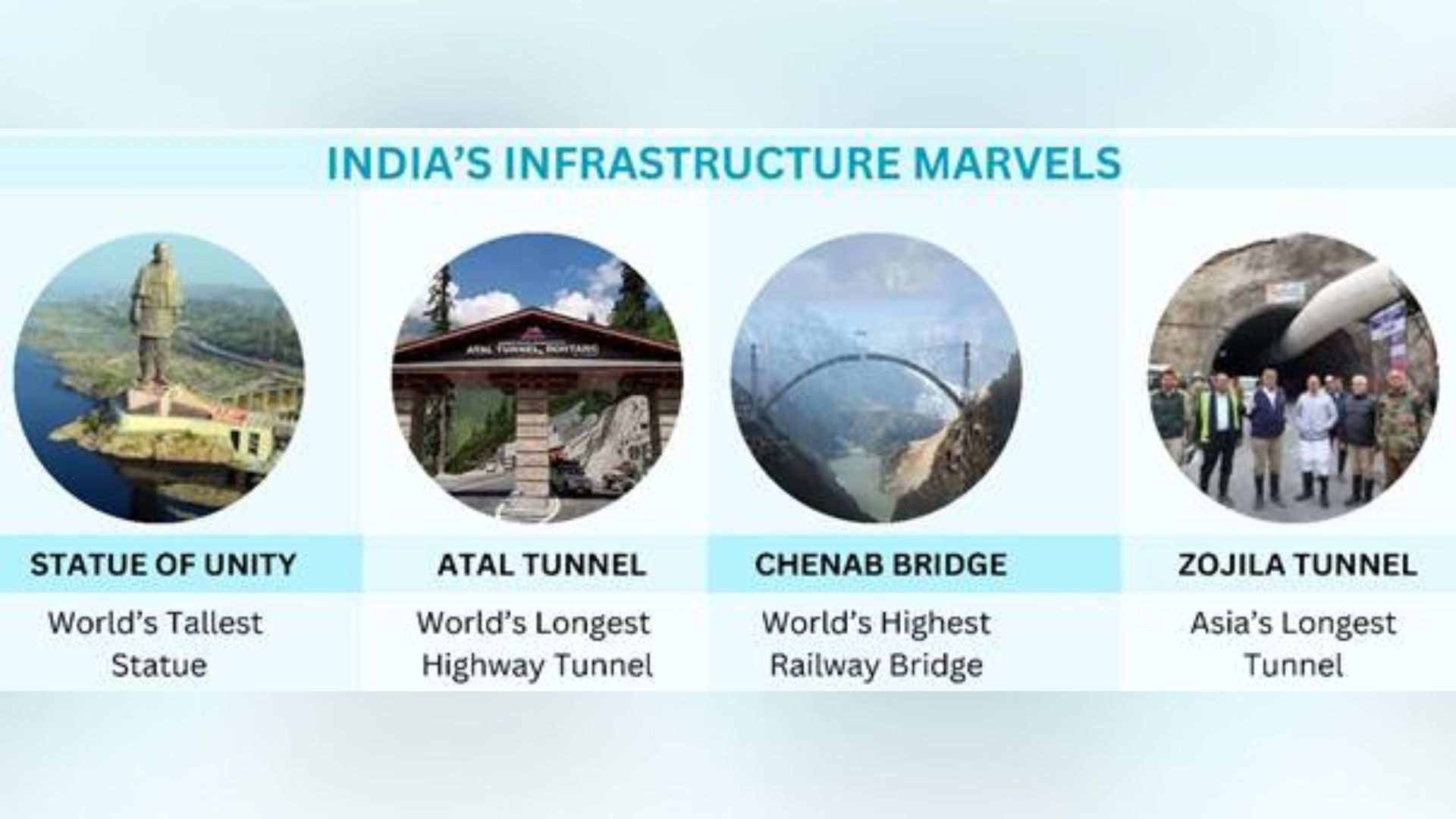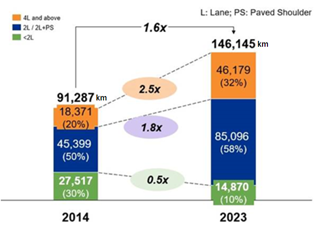
The Government of India has embarked on an ambitious journey to revolutionize the country’s infrastructure landscape, aiming to bolster economic growth, enhance connectivity, and improve the quality of life for its citizens. With a focus on modernizing transportation networks, upgrading urban amenities, and expanding digital infrastructure, the government has launched several transformative initiatives.
From the development of highways, railways, and airports to the promotion of waterways and ropeway systems, these efforts are aimed at fostering inclusive and sustainable development across the nation.
India has achieved significant milestones in infrastructure development, including the inauguration of the world’s longest highway tunnel, the Atal Tunnel, and the construction of the world’s highest railway bridge, the Chenab Bridge.
Additionally, India has set records by unveiling iconic landmarks like the Statue of Unity – the world’s tallest statue and embarked on transformative projects like the Zojila Tunnel, Asia’s longest tunnel, for all-weather connectivity in Ladakh.
Further, from the architectural excellence of the Atal Setu in Mumbai, Bogibeel Bridge over Brahmaputra, Jaiswal Bridge and Dhola- Sadiya Bridge in the northeast, the infrastructure landscape in New India is reaching unprecedented heights.
REVOLUTIONIZING INDIA’S ROADWAYS
The progress of national highways in India has been remarkable in the last 10 years, reflecting a significant increase in budget allocation and construction pace. Since 2014, there has been a 500% increase in the road transport and highway budget allocation, leading to a substantial enhancement in infrastructure development. The speed of highway construction reached an impressive 37 km/day in 2020-21, marking a record for the fastest highway construction in India.
Moreover, the National Highway (NH) network has expanded by 60% from 91,287 km in 2014 to 1,46,145 km by the year 2023. The length of 4-laned NH has increased by 2.5 times, from 18,387 km in 2014 to 46,179 km, as of November 2023. The average pace of NH construction has also seen a remarkable increase, rising by 143% to 28.3 km/day from the baseline 12.1 km/day in 2014.
With a comprehensive network spanning 1,46,145 km, national highways play a crucial role in connecting regions and spurring economic growth across the country, complementing the extensive state highways spanning 1,79,535 km and other road infrastructure spanning 65,45,403 km.
TRANSFORMING RURAL CONNECTIVITY THROUGH PMGSY
India has witnessed significant progress in rural road infrastructure, with an impressive 3.74 lakh km of roads constructed since 2014 under the Pradhan Mantri Gram Sadak Yojana (PMGSY). This achievement has resulted in over 99% of rural habitations being connected, demonstrating the government’s commitment to enhancing accessibility and connectivity in rural areas. As of now, a staggering 7.55 lakh km of rural roads have been completed as compared to 3.81 lakh km of roads in 2013-14.
BHARATMALA: EXTENSIVE ROAD INFRASTRUCTURE DEVELOPMENT
The Bharatmala Pariyojana was launched with the primary focus on optimizing the efficiency of the movement of goods and people across the country. The key components of the Pariyojana are Economic corridor development, Inter-corridor and feeder routes development, National Corridors Efficiency Improvement, Border, and International Connectivity Roads, Coastal and Port Connectivity Roads and Expressways. 25 Greenfield high-speed corridors have been envisaged for development under Bharatmala Pariyojana. Out of which, 20 are completed or under various stages of implementation.
34,800 km of National Highway length was planned for development under Phase-I of Bharatmala Pariyojana. As of Dec-2023, 26,418 km (i.e., 76% of 34,800 km) have been awarded for construction with completion of about 15,549 km.
ADVANCEMENTS IN INDIA’S RAIL NETWORK
India’s railway development reflects a remarkable stride towards modernization and improved connectivity, showcasing the Government’s commitment to enhancing transportation infrastructure for the nation’s progress.
MODERNIZING RAIL TRAVEL THROUGH VANDE BHARAT TRAINS
The Vande Bharat trains represent a significant advancement in India’s railway infrastructure, boasting enhanced safety features, faster acceleration, and improved passenger amenities.
Equipped with Automatic Plug Doors, Reclining Ergonomic Seats, and Mobile charging sockets for every seat, these trains offer a comfortable and convenient travel experience.
As of January 31, 2024, more than 100 Vande Bharat train services are operational across the Indian Railways, with an impressive overall occupancy rate of 96.62% during 2022-23.
Further, on March 12, 2024, Prime Minister flagged off 10 new Vande Bharat trains. During his address, he informed that that not only most of the states have got Vande Bharat trains but the century of Vande Bharat Trains has also been hit.

REVAMPING INDIA’S RAILWAY STATIONS
The Amrit Bharat Station Scheme has been launched for the development and modernisation of Railway stations in India. This scheme envisages the development of stations on a continuous basis with a long-term approach. The scheme has seen significant progress with 1318 stations selected for redevelopment.
ELECTRIFYING INDIA’S RAILWAYS
With a vision of providing eco-friendly, faster, and energy-efficient mode of transportation, Indian Railways is marching ahead towards 100% electrification of Broad-Gauge tracks. Total Broad Gauge (BG) network of 61,508 Route Kms have been electrified up to December 2023 which is 93.83 % of the total Broad-Gauge route (65,556 RKMs) of Indian Railways.Until 2014, 21,801 KM of the broad-gauge network was electrified.
INDIA’S METRO RAIL EXPANSION
The expansion of India’s Metro Rail system has revolutionized urban commuting, with the network set to increase from 248 km in 2014 to an impressive 945 km by 2024. This significant growth reflects the vital role of Metro Rail in providing ease of transportation to urban populations, with approximately 1 crore passengers benefiting from the system daily. From just 5 cities in 2014, the Metro Rail network has expanded to serve 21 cities across the country, with 919 km of lines under construction in 26 additional cities. Additionally, the introduction of India’s first State of Art Namo Bharat train, operating on the Delhi-Meerut RRTS (Regional Rapid Transit System) corridor, further underscores the nation’s commitment to enhancing regional connectivity and modernizing its transportation infrastructure.
ENHANCING INDIA’S AVIATION LANDSCAPE
India’s aviation landscape tranformed with the launch of UDAN Scheme and the operationalization of greenfield airports, contributing to enhanced connectivity and accessibility across the country. India’s aviation sector has witnessed significant expansion with 545 routes operationalised under the Ude Desh ka Aam Nagrik (UDAN), aimed at improving air connectivity to underserved regions. Alongside route expansion, 21 Greenfield Airports have been identified for development in the country, out of which 12 have been operationalised reflecting the government’s commitment to enhancing air travel infrastructure.
HARNESSING INDIA’S WATERWAYS
India’s waterways have seen significant development, with 111 waterways designated as National Waterways (NW) under the National Waterways Act, 2016, showcasing the nation’s commitment to enhancing inland water transportation infrastructure. This recognition aims to boost connectivity, promote trade, and facilitate smoother transportation of goods and passengers across diverse regions of the country.
Source: Press Information Bureau